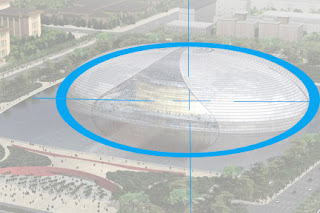Form
Primary Solid
Primary solids are cube, sphere, cylineder, cone, and pyramid. They are volumetric forms which are regular and easy to recognize.
This image represents a sphere which is a centralized and highly concentrated form. Also, it has a dimension and diameter. It is located on the center of the room which has a focal point on its.
This image represents a sphere which is a centralized and highly concentrated form. Also, it has a dimension and diameter. It is located on the center of the room which has a focal point on its.
Dimensional Transformation
Dimensional Transformation is a form that can be transformed by changing one or more of its dimensions but still keep its original character as a subclass of forms. Generally, there are three patterns used to describe dimension transformation. A pyramid can be transformed by changing the dimension of the base or adjusting the height of the apex. A cube can also be transformed by reducing or extending its height, width, or depth as same as a sphere or otheres.
This image below presents the National Grand Theater in Beijing, China. Its original form is the sphere that is transformed into an ellipsoidal form by extending it’s along an axis.
Dimensional Transformation is a form that can be transformed by changing one or more of its dimensions but still keep its original character as a subclass of forms. Generally, there are three patterns used to describe dimension transformation. A pyramid can be transformed by changing the dimension of the base or adjusting the height of the apex. A cube can also be transformed by reducing or extending its height, width, or depth as same as a sphere or otheres.
This image below presents the National Grand Theater in Beijing, China. Its original form is the sphere that is transformed into an ellipsoidal form by extending it’s along an axis.
Overlay
Subtractive form
Subtractive form is a form that can be transformed by removing a portion from the whole volume of one form. However, the form can maintain its original character or be changed totally into a form of another family, depending on the process of transformation. For example, a sphere can retain its identity as a sphere although some portions are removed. However, if many portions of the sphere are removed, it may become the cube.
The building below is a good example of subtractive form. There are a lot of rectangular windows on this building that are subtracted the building’s volume while it is still keep its identity, a cylinder.
Additive Form
Additive Form is a form that can be transformed by adding any portions to its volume. The additional portion that attached the original form can alter or retain its identity. Mostly there are three types of additive forms. Spatial Tension is relationship among each form by sharing of the common identities such as color, shape, and texture. Edge-to-edge Contact also presents the forms which share common edge.
The image below presents Face-to-Face Contact that the relationship among forms has corresponding planar surface and parallel each other. The building is extended several small rooms into each side of building.
Radial Form
Radial Form is a form that is composed of linear forms extending from the center point of the element to its outside in a radiating way. Besides, this form is composed of the features of centrality and linearity into one particular combination.
This image below is a radial form. The building is shaped like a large coin, with a square hole in the middle which is a center of its.
Coin Building
Formal Collision of Geometry
Formal collision of geometry begins when two forms which have difference in geometry collide, interpenetrate, link, and merge each other boundary to provide the new form. Besides, this new form will retain and share both original identities. There are four types that can describe this formal collision. Two forms can merge to create the new form that totally different from both individual original forms. Sometimes formal collision may happen when two forms receive the other totally within its volume. The formal collision may begin when retain individual characters and interlocking some part of their volume.



















additive form picture really make sense, i can really see the additive forms on the building! :D
ReplyDelete